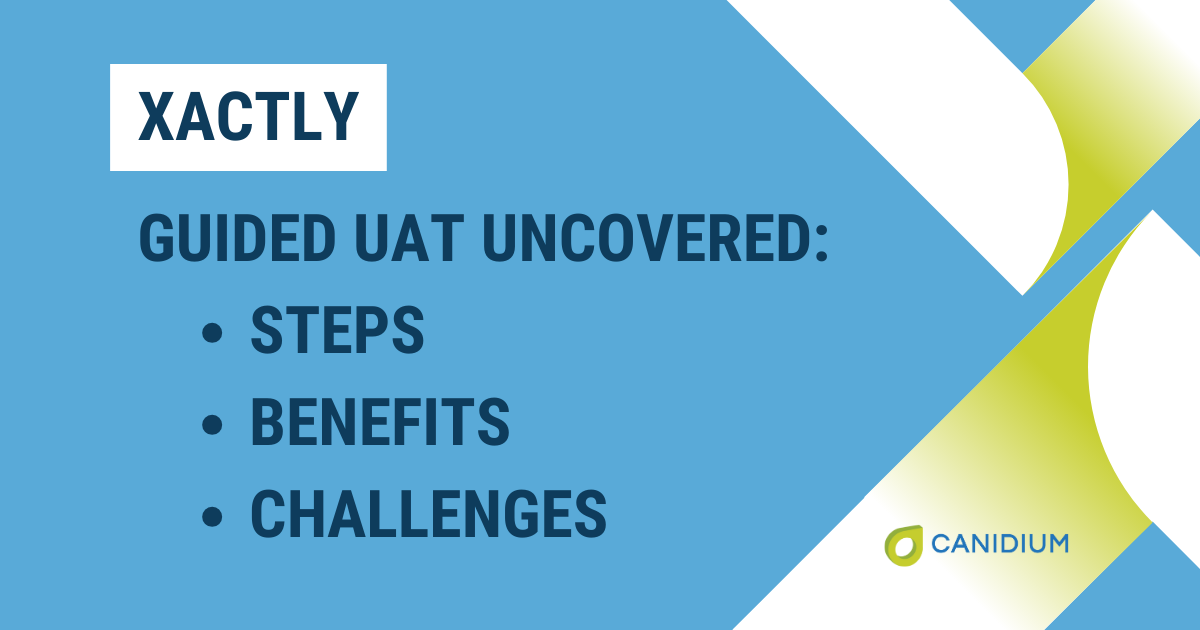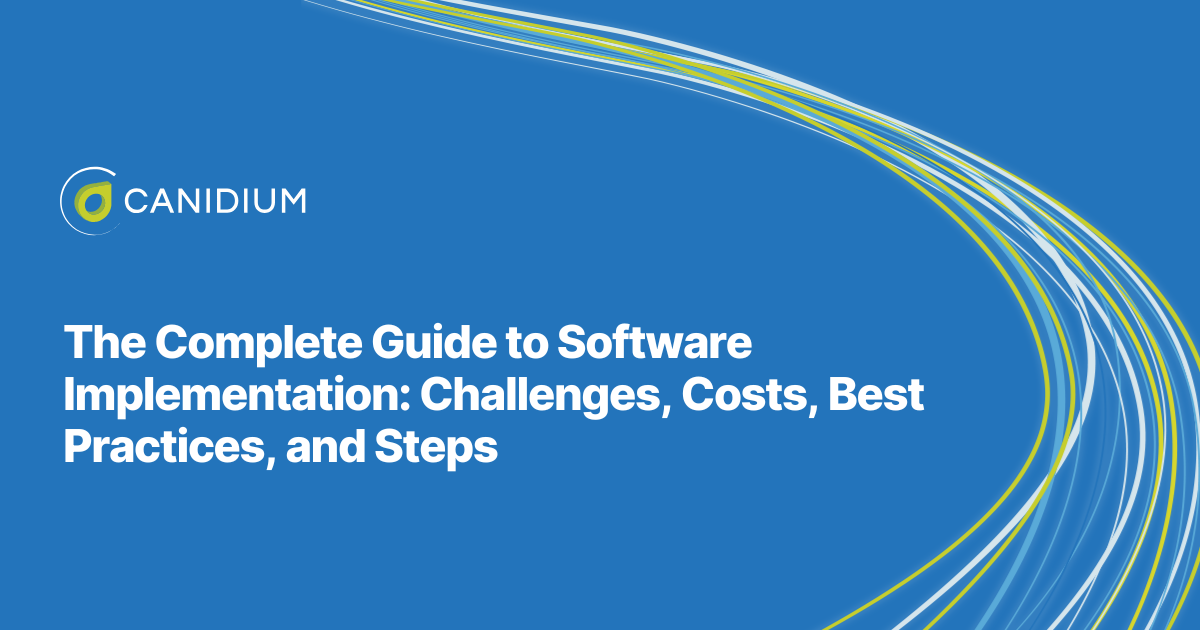User Acceptance Testing (UAT) is a critical phase in software implementation, ensuring the system meets business requirements before going live. While UAT can be conducted remotely, many organizations are turning to Guided UAT, also known as on-site UAT, for its unique benefits. In this article, we'll explore Guided UAT, its steps, benefits, and challenges, and also touch upon the concept of On-site Kickoff.
To share a deep understanding of Guided UAT and its benefits, we asked Adam Shiring, Technical Practice Lead for Xactly at Canidium, for his hands-on experience with Guided UATs. Adam has been in the compensation industry for over 10 years (3.5 on the administrative side, 6.5 on the consultative side). He sees the benefits of on-site collaboration first-hand.
In this article, we will explain:
- What Guided UAT is
- What steps are typically involved in Guided UAT
- What the benefits of Guided UAT are
- What the challenges of Guided UAT are
What is Guided UAT?
User Acceptance Testing (UAT) is the final stage of any software development or change request lifecycle before the software goes live. It is conducted to ensure that the software performs as intended in real-world scenarios. During UAT, customer adminstrators test the software to determine if it meets their organization’s business requirements and to validate the changes made. The primary objective of acceptance testing is to validate the end-to-end business flow of the software.
Guided User Acceptance Testing (UAT) is a collaborative software testing process between the software implementation's testing team and select members of the client's team. The difference between typical UAT and Guided UAT is that this testing is conducted on-site at the client's location, allowing both teams to work closely together and address any issues that arise during the testing process in real-time.
During the global pandemic, on-site UAT was scaled back, but in a safer environment, it has been utilized more frequently. The guided UAT approach enables a more thorough understanding of the system being tested, thanks to the real-time transfer of information. This approach makes the testing process more effective and allows for quicker resolution of any issues.
6 Steps Involved in Guided UAT
While UAT can and has been conducted remotely, many organizations are returning to Guided UAT for its unique benefits. Guided UAT involves working the testing process on-site at the client's location, allowing for closer collaboration, immediate issue resolution, and a more thorough system understanding. This section will explore the steps involved in a Canidium Guided UAT.
1. Introductory Meeting
Purpose: This initial meeting sets the tone for the UAT process, allowing both teams to get acquainted and establish a rapport.
Activities:
- Introductions: Team members from both sides, including critical stakeholders and testers, introduce themselves.
- Overview of Objectives: The purpose of the UAT, key goals, and expectations are discussed to align everyone's understanding.
2. System Walkthrough
Purpose: This step provides an in-depth understanding of the system being tested, including its functionalities and configurations.
Activities:
- Overview of System Components: The testing team presents an overview of the system, highlighting key components and functionalities.
- Environment Familiarization: Clients familiarize themselves with the testing environment, including access to necessary tools and systems.
3. Data Loading
Purpose: Loading test data and performing manual data validation ensures the system calculates values correctly.
Activities:
- Data Preparation: Test data is prepared based on predefined scenarios and requirements.
- Data Loading: The prepared data is loaded into the system, and calculations are verified manually to ensure accuracy.
4. Testing Scenarios
Purpose: Walking through various test scenarios helps validate system functionality and ensures it meets business requirements.
Activities:
- Scenario Execution: Clients drive the testing process by executing predefined test scenarios while the testing team provides guidance and support.
- Issue Identification: Any issues encountered during scenario execution are documented and addressed immediately.
5. Issue Resolution
Purpose: Immediate troubleshooting and issue resolution minimize downtime and ensure a smoother testing process.
Activities:
- Problem Identification: Issues identified during testing are categorized and prioritized based on their impact.
- Troubleshooting: The testing team works closely with the client to resolve issues, either through configuration changes, data adjustments, or system fixes.
6. Wrap-Up
Purpose: Reviewing the day's progress and setting goals for the next day help maintain focus and momentum throughout the UAT process.
Activities:
- Progress Review: The day's testing activities and achievements are reviewed to assess progress toward UAT goals.
- Goal Setting: Based on the day's outcomes, goals and priorities for the next day are established to keep the testing process on track.
Guided UAT is done in a systematic way, following a set of steps to ensure that every aspect of the system is tested. These steps include defining the scope, preparing test cases, executing the test cases, tracking the defects, and retesting the defects. By following these steps, the testing process becomes more comprehensive and methodical, leading to a more successful implementation of the system.
Guided UAT is a crucial step in the software development life cycle that ensures the system meets the business requirements and end-user needs. By following a systematic and thorough testing process, the implementation is more successful, and the system is more reliable and efficient.
Benefits of Guided UAT vs. Remote UAT
Choosing between guided in-person sessions and remote interactions can significantly impact the outcome of a project. The benefits of Guided UAT, where the implementation partner is physically present, versus Remote UAT, where interactions occur virtually, are substantial. Here, we explore why Guided UAT can offer unique advantages:
- Relationship Building: Building relationships is essential to any business. Face-to-face interactions can help build stronger relationships with clients and team members. It is important to prioritize these interactions to foster trust and communication.
- Dedicated Attention: Our team is on-site, so no other projects are managed. During Guided UAT, an organization has the full time and attention of their implementation partner.
"I think the biggest benefit of Guided UAT is the dedication the client receives. When you're virtual the customer gets a two-hour block at a time. When we're on site, it's a full eight hours and the feedback loop is uninterrupted."
- Adam Shiring
- Immediate Issue Resolution: Momentum impacts human learning and by having a dedicated team on-site, questions can be answered quickly with no other tasks pulling at your implementation team.
- Efficiency: Guided UAT leads to quicker issue identification and resolution, leading to shorter testing cycles. This means an organization's team utilizes the solution sooner and with more expertise.
"Guided UAT often increases the efficiency and the overall familiarity with the system in a much shorter timeframe. When we're there live, it's much easier for us to walk them through challenges and scenarios and get them resolved in real time."
- Adam Shiring
Challenges of Guided UAT
Navigating the complexities of software implementation often involves overcoming various challenges, and Guided User Acceptance Testing (UAT) is no exception. While Guided UAT offers unique advantages, it also presents several challenges that organizations must be aware of.
Cost
When it comes to on-site visits, additional costs, such as travel expenses and accommodation costs, need to be taken into account. This is often a sticking point for clients considering whether or not to choose Guided UAT.
However, it's worth noting that many of our clients have reported significant cost savings in other areas due to implementing Guided UAT. For example, the efficiency of the guided testing process can lead to a reduction in managed services costs, while the additional training provided as part of the UAT process can also help to reduce training expenses over time. Ultimately, while some upfront costs may be associated with on-site visits, the long-term benefits of Guided UAT often make it a more cost-effective option overall.
Time Commitment
UAT is crucial for software development. It requires dedicated time from clients and testing teams, which can be challenging for busy teams. The idea of allocating 8-hour days to a Guided UAT is daunting for many clients.
Allocating sufficient time for UAT is critical for achieving a thorough understanding of the solution and ensuring a successful outcome. Clients who choose Guided UAT walk away with a thorough understanding of the solution, which enables them to start using it immediately. Alternatively, if UAT is done in small chunks of time, understanding can be delayed and lead to more clarification needed later.
Scope Change
One concern a client may have about Guided UAT is that it can lead to changes in requirements. As the client uses the solution and identifies issues or areas where improvement is needed, the development team can adjust the solution to meet the client's needs better. Since these discussions happen in person, having detailed conversations and better understanding the client's feedback is easier.
While a gap in scope/requirements may be discovered during the UAT phase, the Guided UAT process allows for those issues to be discovered quickly and efficiently. This results in a more effective way to address any issues or concerns the client may have and ensure that the final solution is of the highest quality and meets the client's needs.
What is On-site Kickoff and its Benefits?
Another on-site service Canidium offers is on-site kickoff meetings. These are held at the beginning of a project. The implementation team meets the client's team in person to discuss project details, goals, and expectations. The benefits include:
- Better Understanding: A clearer understanding of project requirements and goals.
- Relationship Building: Establishing rapport and trust with the client early in the project.
- Efficiency: More efficient planning and execution due to in-person collaboration.
Challenges and Rewards of Guided UAT
Despite its challenges, Guided UAT offers valuable benefits for software implementation projects. The closer collaboration, immediate issue resolution, and relationship building they facilitate can lead to more successful projects and satisfied clients.
Guided User Acceptance Testing (UAT) offers a robust software testing approach, focusing on collaboration and immediate issue resolution. While it presents challenges such as cost, time commitment, and scope change, the benefits often outweigh these concerns. By conducting UAT on-site, organizations can build stronger relationships, receive dedicated attention, and achieve more efficient testing cycles.
The insights shared by Adam Shiring, Technical Practice Lead for Xactly at Canidium, highlight the importance of on-site collaboration in UAT. His experience emphasizes the value of face-to-face interactions and the efficiency gained from uninterrupted feedback loops during Guided UAT.
Guided UAT offers valuable opportunities for organizations to enhance their software implementation projects. The benefits of closer collaboration, immediate issue resolution, and relationship building can lead to more successful projects and satisfied clients.








